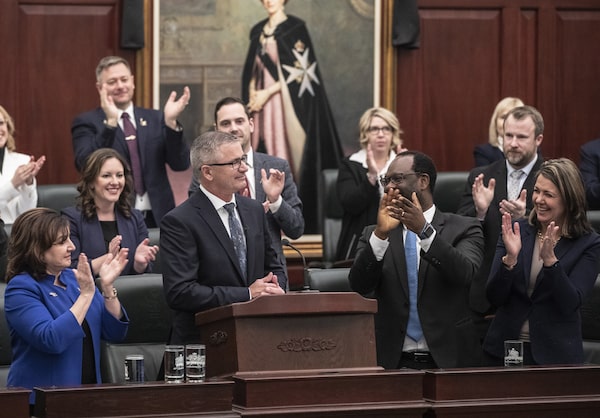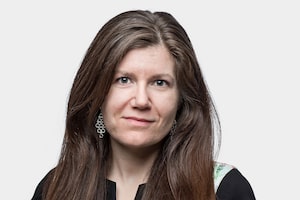
Alberta Finance Minister Travis Toews is applauded as he delivers the 2023 budget in Edmonton on Feb. 28.JASON FRANSON/The Canadian Press
Key takeaways from the 2023 budget
- The newly created Alberta Fund will allow the government to use surplus cash practically any way it sees fit. This can include debt repayment, additional deposits to the long-term savings Heritage Fund or “one-time initiatives” that do not lead to permanent increases in government spending, including capital projects.
- Non-renewable resource revenue is forecast at a record $27.5-billion in 2022-23, reflecting the surge in global energy prices as demand recovered from the pandemic and after the Russian invasion of Ukraine. Alberta government revenue reached a record $76 billion as a result.
- Tuesday’s budget assumes the North American benchmark West Texas International oil price will average US$79 per barrel in 2023-24, about $11.50/bbl lower than forecast for 2022-23. Prices are expected to continue to fall, dropping to US$73.50/bbl by 2025-26.
- Health care spending is jumping by about four per cent with $965-million being added to the ministry’s operating budget from the 2022-23 forecast – an increase that is partially offset by a top-up of the Canada Health Transfer. Funding is to go towards some of the government’s key objectives, including improving wait times for ambulances, emergency rooms and surgeries, plus the recruitment of frontline health workers.
- Nearly $2-billion is being put aside for the K-12 education budget over the next three years, including about $820-million to ensure school authorities can meet the demands from record enrollment. About $372-million is allocated for new school construction projects, but the budget does not provide specifics.
- Post-secondary students will see tuition caps of two per cent annually beginning next year, as part of the government’s affordability measures. Grace periods on loans are also being stretched to one year from six months following graduation, increasing the threshold for repayment assistance for student loan borrowers from $25,000 to $40,000.
- While the Alberta government is still considering the creation of its own provincial police force, Budget 2023 does not allocate funding for one. However, an increase of $84-million has been earmarked to fund contract policing and Alberta Sheriffs, in addition to funding for municipalities to explore alternative policing models.
Alberta, which expects to post a $2.4-billion surplus this year, plans to establish a new fund the government can use to pay for one-time projects, creating a deep pool of cash Premier Danielle Smith could dip into as she outlines priorities ahead of the province’s spring election.
The United Conservative Party government, in its 2023-2024 budget unveiled on Tuesday, proposes requiring that one half of the province’s surpluses to be used to repay debt maturing in the same fiscal year. Politicians would then have financial leeway over the remaining 50 per cent – making more than $1-billion available to the Alberta Fund in the coming year if the forecast surplus is achieved.
Finance Minister Travis Toews said the fund was conceived “to bring discipline to the use of surplus.”
“It’s anything but a slush fund,” he said.
The budget is the first under Ms. Smith’s leadership, and comes just months before a scheduled May election. The government, which finds itself awash in cash because of oil and gas royalties, presented a budget with no new taxes and billions in new spending.
The budget calls for a $2.37-billion surplus in 2023-2024, compared with an updated forecast surplus of $10.39-billion for the year ending March 31, 2023.
Alberta non-renewable resource revenue forecast to hit record high of $27.5-billion
Alberta’s budget shows it’s not the absolute best of times, but it’s still close
According to the new fiscal framework, the government will be able to allocate roughly $1.4-billion to the Alberta Fund in the coming fiscal year. This reflects 50 per cent of the coming year’s surplus and adjustments, plus an adjustment owing to the year about to end.
The 50-per-cent leeway can be used to further pay down debt, direct money toward the Alberta Heritage Savings Trust Fund, a long-term savings fund, or spend on “one-time initiatives that do not lead to permanent increases in government spending,” according to the budget.
The budget forecast assumes it will be used to repay debt in 2024-2025, a finance official noted. The Globe and Mail is not naming the official because the government won’t allow individuals made available for budget background information to be identified.
Mr. Toews argued the new fiscal framework’s other key components – a proposed law against deficits and limiting increases in operating expenses to inflation plus population growth – will help prevent politicians from using the surplus cash inappropriately.
“The fiscal framework, the layering of protection, I believe will ensure that governments cannot act irresponsibly, ahead of an election per se, and spend a surplus that’s sitting in the [account],” Mr. Toews said.
The Finance Minister, however, conceded that the proposed rules do not come with ramifications for politicians who fail to balance budgets. The proposed rules also come with caveats that permit governments to dip into the red without running afoul of the law.
Alberta plans to spend $68.28-billion and collect $70.65-billion in revenue in 2023-2024. In 2022-2023, the province expects to spend $65.63-billion and rake in $76.02-billion in revenue, thanks to record energy royalties.
The smaller surplus in the coming fiscal year largely reflects the swing in energy prices and, while a significant shift, leaves the province in a much better place compared to expectations just one year ago. Tuesday’s budget also calls for surpluses in 2024-2025 and the year after.
The 2023-2024 budget is contingent on West Texas Intermediate crude trading at an average of US$79 per barrel in the fiscal year, down US$11.50 per barrel compared with 2022-2023.
Ms. Smith campaigned to take over the United Conservative Party in part on a promise to revamp the health care system. The health department’s budget will hit $24.53-billion, up 4 per cent or $965-million, next fiscal year. This extra cash, which includes money from the federal government’s Canada Health Transfer, will go toward some of the government’s key objectives, including shortening waiting times for ambulances, emergency rooms and surgeries. It will also be used to lure health workers.
Education funding, meanwhile, climbed to $8.83-billion, up from $8.47-billion in the year ending March 31.
The UCP is still mulling whether to create a provincial police force and the budget does not allocate funding for one. However, the government increased spending on public security by $84-million to expand policing options and the operations of Alberta Sheriffs Branch. The government this year dispatched sheriffs in Edmonton and Calgary, which have their own police services, as part of a pilot project the government hopes will help quell social disorder and assist those struggling with addiction.
New Democratic Party Leader Rachel Notley expressed doubt on the government’s growth and employment projections and said funding for critical services, such as health care and education, do not account for population growth and inflation. She called the budget a ploy to solicit votes.
“What we see here is the consequence of four years of the UCP starving these critically important public services and then, immediately in the advance of an election, trying to catch up very quickly,” Ms. Notley said in an interview.
“I don’t think they put this together with the view to do anything more than campaign on it.”
Lori Williams, a political scientist at Mount Royal University, said the budget shows the UCP is responding to criticisms from the public and, in a way, undercuts some of the critiques lobbed by the NDP.
She said the budget is designed for an election victory, but the coming vote will focus neither on how much money is being spent nor the overall plan. Instead, voters will consider which party is “competent and trustworthy” enough to deliver on the promises – notably on health care and education.
“It is going to come down to whether people think the investment is going to pay off, whether it’s being wisely spent, or if it’s just throwing money in an attempt to win votes,” Ms. Williams said.
She added that while the UCP is billing the Alberta Fund as a savings account, it is really a spending account. It is unclear why the new fund is necessary, she said, given the province already has the Heritage Fund.
“It’s just meaningless,” she said of the Alberta Fund.
 Carrie Tait
Carrie Tait Alanna Smith
Alanna Smith